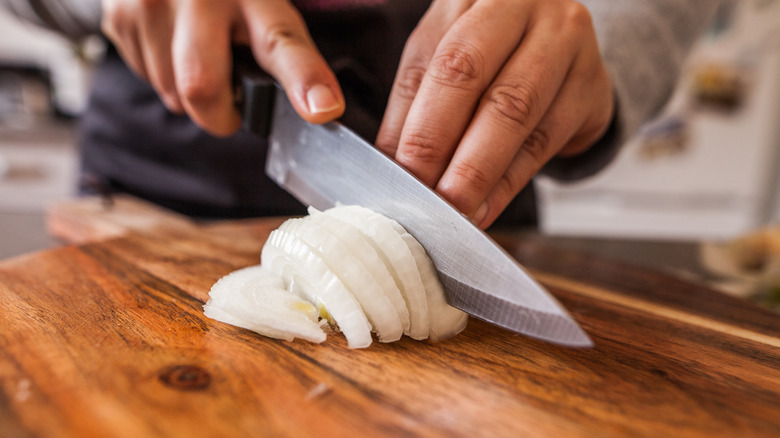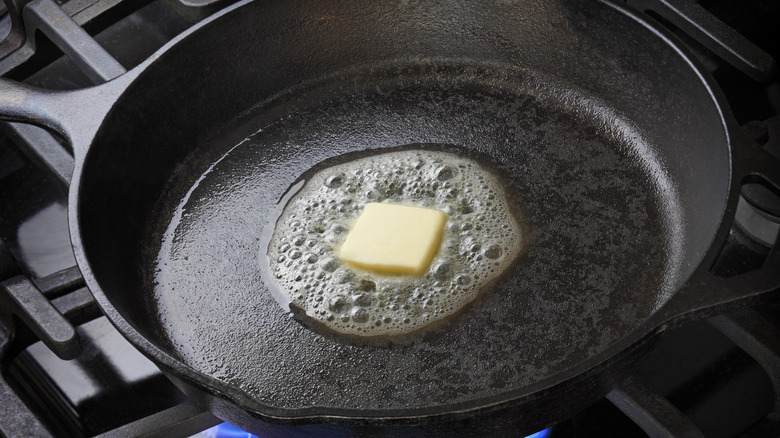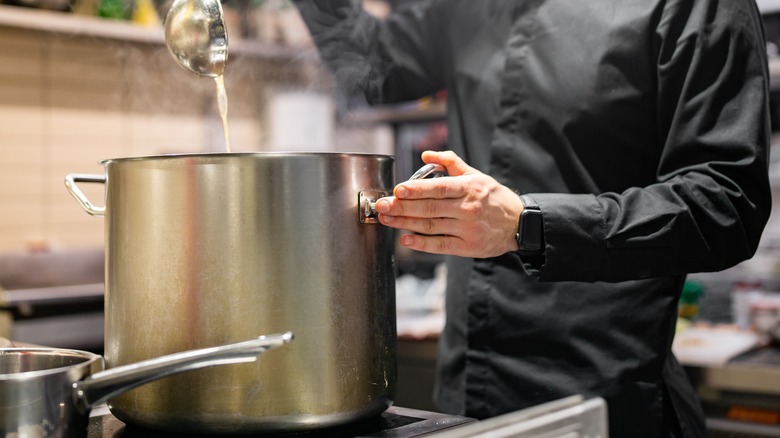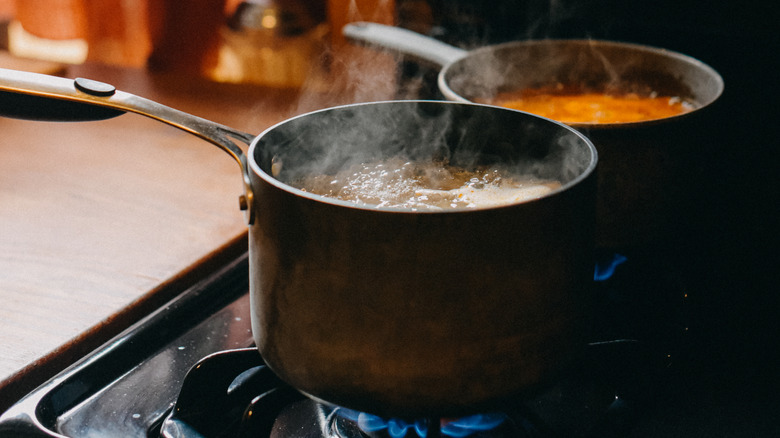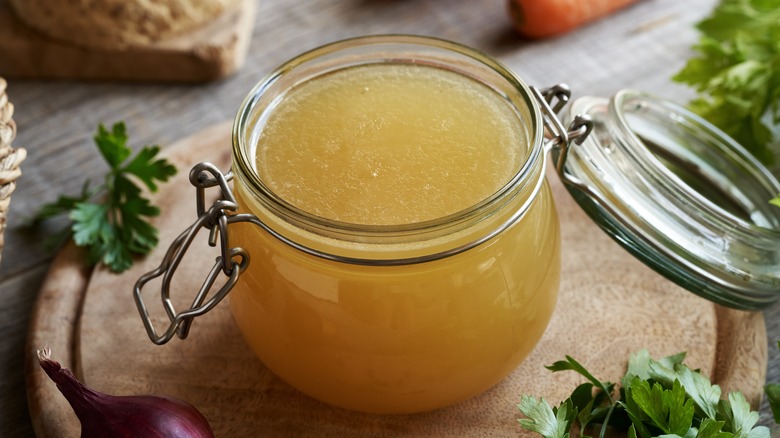Chefs Share The Tricks And Tips They Use To Create A Restaurant-Quality Bowl Of Soup
You go to a restaurant and eat a bowl of soup that's seasoned impeccably, with a delicate balance of flavors and a perfect texture. Then, you make soup yourself at home and it comes out with a muddy mix of flavors, lumpy, and under seasoned — or just lacking something you can't put your finger on. This is a fate that befalls many home cooks who love soup. They just can't reach the heights of a restaurant quality soup. But, why?
I wanted to learn some professional soup secrets, so I interviewed three chefs to learn the tricks of the trade. There's more that goes into a restaurant soup than you might imagine — more onions and other aromatics, more butter, and more fancy accompaniments. Though, of course, there's more to it than that. Chefs know how to balance flavors, choose quality ingredients, and let star components shine. Plus, they have training and experience to back it all up. Here are some of the tricks and tips chefs use to create a restaurant-quality bowl of soup.
Soup in restaurants often uses more onions
If you want to make a soup that tastes amazing, you have to start building flavor right from the start. And, in most cases, that begins with onions. Many soup recipes call for a single onion. Maybe two for a large pot. However, chefs are often heavy-handed with them.
"I think we definitely use more onions in a restaurant environment than in a home kitchen," says James DiBella, head chef of Link & Pin and The Cellar in Charlotte, North Carolina. Chef Olivier Koster of Cast & Crew in Daytona Beach, Florida remarks that it depends on the soup, but "onions and garlic are an amazing base and are used a lot more in professional kitchens than at home."
Onions bring more depth of flavor to soup than you probably realize. Soups without onions or with too few onions are often bland and lacking in flavor. Although, some recipes may use an alternative, such as leeks. They also need to be sautéed before adding the other ingredients if you want them to taste their best. You might even want to caramelize them to add more flavor — and we have some tips for the perfect caramelized onions, if so.
Chefs make heavy use of aromatics when making soup at restaurants
Onions are what's known as an aromatic in the culinary world. This is the name given to vegetables, herbs, and spices used toward the start of cooking to create a flavorful base for a dish. But, onions certainly aren't the only aromatics chefs use to make soups. In fact, it's careful use of these kinds of ingredients that helps make restaurant soups (and other dishes) more flavorful.
"I find myself using a wide variety of aromatics depending on what type of soup I will be preparing," says chef James DiBella. He tells us he almost always starts with a mirepoix, before adding garlic, black peppercorn, fresh thyme, and bay leaves. If you're wondering what a mirepoix is, it's a mix of diced onions, celery, and carrots. However, which aromatics DiBella uses depends on what soup he's making. "For example, if I am making a soup inspired by Thailand, I might use a base of aromatics using shallots, garlic, chiles, and lemongrass," he explains. "Aromatics are fun to play with and will make a soup more fragrant, which also helps the stock taste deeper — which, in turn, will yield a better-tasting soup."
Soup at restaurants focuses on one or two ingredients to let them shine
Have you ever noticed your homemade soup tasting muddy? We don't literally mean tasting like mud, but lacking depth and brightness with no standout flavor. This is common when you try to use too many competing ingredients. Like, when you try to clear out your crisper by making a vegetable soup with whatever you have lying around. At restaurants, chefs tend to focus on one or two standout ingredients and give them room to take center stage.
"You want the main ingredients of the soups to shine," chef Olivier Koster tells us. "If tomatoes are in season, you would want to taste the tomato and not all of the other vegetables you added to the soup," he explains. Of course, you'll still want to use veggies as aromatics — onions, carrots, and celery are all good choices — then stick to just one main ingredient, such as pumpkin, spinach, or broccoli.
The types of ingredients you choose are important. "Try choosing vegetables that are not too overpowering in taste," chef James DiBella says. "The amount of protein you use in the soup should always outweigh the vegetables." Some veggies are best avoided in soup. "I would stay away from overly bitter vegetables or vegetables that have a bit of that 'dirty' flavor," says Bernhard Mairinger, chef and owner of Los Angeles area restaurant Lustig. "My favorites to use in soups are butternut squash, sunchoke, carrot, and kohlrabi."
Chefs know how to balance flavors in soup
Creating the perfect balance of flavors isn't easy. Chefs are trained to do it, but the average home cook might not have the know-how. However, it is something you can learn if you want to improve your homemade soup — and, indeed, any other dish. "Balance in a soup is probably the most important thing and is what distinguishes a restaurant soup from a soup made at home," says Olivier Koster of Cast & Crew. He gives us an example of balance: "A little bit of acidity to counter some of the richness of soups will wake them up and make it more exciting to eat."
According to James DiBella of Link & Pin and The Cellar, "Knowing how to balance sweet, salty, sour, bitter and umami elements" is important. "Proper simmering is key here, as it allows flavors to meld together and mellow out, creating that balance," he adds. DiBella also believes "a big key to creating balance is by layering your flavors gradually — you can also add some acid (like lemon juice) to brighten up the soup as a garnishing element to round things out."
Texture can also play a part in balancing a dish. "If your soup base is creamy and luscious, you can create some wonderful contrast by adding something crunchy, like roasted nuts," DiBella remarks.
Restaurant soups often contain more butter than homemade ones
Wondering why your favorite restaurant soup is so delicious? Well, it might be all the butter. "Restaurant soups definitely contain more butter than homemade soups," says chef Bernhard Mairinger. He says that he tends not to use much oil in soups, other than for roasting vegetables to go in them, whereas butter is another matter.
Chef James DiBella agrees that butter is where it's at. "Most chefs cook many of their ingredients in butter instead of vegetable or olive oil," he notes. "Considering how much more flavor butter imparts, it just makes sense." He adds that "a chef will always say fat equals flavor!" So, if you want your soups to taste more like restaurant soups, a healthy dose of butter might be the answer.
That said, not all our experts use a lot of fat in their soups. "I use only a little oil or butter in a soup," chef Olivier Koster tells us. "We get all our flavors from good ingredients and homemade stock." From that, we can conclude that butter is one way to add flavor to soups, but not the only way.
Chefs may elevate the accompaniments to restaurant soup
Sometimes, at a restaurant, it's not just the soup itself that's incredible but the accompaniments that come with it. At home, you probably eat soup with a dinner roll or a hunk of crusty bread. Maybe you serve a soup and grilled cheese sandwich combo, if you're feeling fancy. But, restaurants often elevate this pairing.
"There are so many little garnishes or side snacks that can be served with a soup that make all the difference," notes Bernhard Mairinger of Lustig. He tells us that his restaurant serves a sunchoke soup with a whipped ricotta truffle crostini. "Our butternut squash soup is accompanied by a pumpkin seed-gruyere grissini," he adds. Both of those sound amazing and prove that the accompaniments matter.
"It is not that the soup would not be great with just a nice slice of toasted bread to dip in it," says Mairinger. But, he advises that "the perfect accompaniment takes the soup into another direction and therefore adds layers of flavors and textures."
Soups at restaurants are made in big batches
While you might make four to six portions of soup in a batch, restaurants are feeding a crowd and make huge vats of it. You might think that soup tastes the same whether you make enough for six or 60, but according to some chefs, this might make a difference to the flavor.
"I think that the main difference between soups made at home and soups made in restaurants is the quantity that we make at the restaurant," Bernhard Mairinger tells us. "There might not be any logical explanation for this," he says, but he's a true believer that "the bigger a batch of something is, the tastier it gets." Logical or not, there could be some truth to it. "That's why I never cook for one person even if it is just me at home cooking for myself," Mairinger says.
With this in mind, you might want to whip up a big batch next time you make soup and freeze the leftovers. You probably won't want to cook up a restaurant-sized amount, but you could double or triple the usual quantity you'd make.
Some restaurant soups are made a day ahead to let the flavors meld
Have you ever noticed that leftovers often taste better than the original dish did on the day you made it? It's not just the joy of being able to reheat rather than cook from scratch, although that can feel life-affirming on a busy day. There's a scientific reason why food often tastes better the next day, as it undergoes chemical reactions that change and improve flavors. And, this could be why soup at restaurants is so much tastier.
"I always try to prepare soups a day in advance versus the day it is served for a few reasons," says chef James DiBella. "First, so the flavor compounds have time to meld together and create a harmonious flavor. For example, in beef stew, the carrots, potatoes, and onions can become sweeter and take on more flavor from the broth."
He mentions that, when you reheat soup, this breaks down proteins further and releases umami compounds, giving the soup a more savory flavor and rounded mouthfeel. "The breakdown of proteins in meat also releases amino acids that can enhance the umami flavor," he tells us. According to DiBella, another reason he likes to make soup a day ahead is that exposure to oxygen helps reduce the bitterness in any ingredients that are high in sulfur. All this adds up to a tastier soup.
Chefs know when to blend soup and when to leave it chunky
When your soup's not quite right and you can't figure out why, it could be because you're blending it when you should leave it chunky or vice-versa. Naturally, there are different opinions on when to blend and when not to blend, but it's good to have some guidelines to work within or to know what the experts think.
"For me personally a blended soup is more of a summer vibe, and chunky soups are for the winter," Olivier Koster says. "And of course, the produce is important. Does it blend well? Do you get a smooth texture? If not, it might be better to make a chunky soup." And, of course, there are some soups that should obviously be left chunky, such as soups containing pasta, noodles, or rice.
James DiBella, on the other hand, tells us that he tends to stick with traditional techniques to guide him. "Soups are generally classified into four main categories: thin, thick, cold, and national, though these categories cover multiple different types of soup," he explains. "Thick soups cover purées, velouté, and cream soups." These are all types of blended soups. "Thin soups can be further split into more categories, including clear, broth, bouillon, and chunky," DiBella notes. These types of soups may have chunks or be clear or brothy without any chunks.
Soups at restaurants often contain homemade stock
Most people reach for boxed stock or bouillon powders when making soup at home, while most restaurants use stocks and broths made in-house. There's a big difference in flavor between homemade stock and the commercial kind and it's bound to make a difference to the finished dish. We're not saying you have to make your broth from scratch — after all, there are many mistakes you can make with homemade stock – but just be aware of the potential difference. And, perhaps choose a high-quality stock from the store.
"All of our stocks are homemade, and we make a vegetable stock almost daily at the restaurant as we use it as a base for almost everything that we cook," chef Bernhard Mairinger tells us. And, he's certainly not the only chef making his own stock. "I always use homemade stock for soups at restaurants, as homemade stock will add a richer, deeper flavor and mouthfeel to soups," says James DiBella.
And, it's not just the flavor, there's more benefit to making your own stock. "Homemade stock is usually unsalted, and as homemade stock is fortified with more flavor, hopefully that means you will need less salt at the end of cooking," DiBella reveals. He notes that making stock from scratch lets you have more control over how much salt is added to the soup.
Chefs use fresh herbs and whole spices in soups
You might be used to cooking with dried herbs and ground spices, but this is where chefs differ. They tend to add an extra punch of flavor by using whole spices and fresh herbs when making soup. Yes, there are all kinds of mistakes you can make when cooking with fresh herbs. And, whole spices must either be removed before serving or need toasting and grinding to make the most of them. However, you shouldn't let all this put you off.
"Fresh herbs can add freshness and flavor to soups, especially hearty herbs like rosemary and thyme which are often used in longer-simmering dishes," James DiBella informs us. "You can add a few sprigs of fresh herbs and remove the stems before serving," he suggests. According to DiBella, other fresh herbs that work well in soups include parsley, cilantro, chives, basil, and mint. Basically, any herb works if it matches the flavor profile of the soup.
DiBella also uses whole spices to create a subtle depth of flavor. "I tend to place the herbs and whole spices into a sachet bag to contain them," he says. "This way I can add the sachet to any soup and remove it when needed without having to fish out the pieces." And, DiBella adds, "A sachet bag is a small piece of cheesecloth that is stuffed with spices and fresh herbs, and then tied with a piece of twine to enclose the ingredients."
The equipment in professional kitchens can make a difference
If your soup isn't coming out as tasty as restaurant versions, it might not be your fault. It could just be that the equipment you have doesn't stand up to what professional chefs have in their kitchens. Sure, we know what they say about bad workers blaming their tools, but we have it on a chef's authority that this could make a difference.
"Chefs also tend to have better equipment and potware to make and prepare soups," says James DiBella. "Your blender at home probably will not compare to a commercial blender, which will always be found in restaurant kitchens," he adds. That perfectly creamy consistency could be eluding you because your blender isn't up to scratch compared to a professional one. And if the flavors are lacking, maybe your pots and pans don't let you get the perfect char on your ingredients.
Soup at restaurants is made by professionals with experience and knowledge
There's not much you can do about this, beyond enrolling in culinary school, but chefs have training, experience, and knowledge that us mere mortals just don't possess. The reason why your homemade soup isn't as good as your restaurant favorite might just be that you lack the cooking skills of a professional chef. It's nothing to be embarrassed about, that's why people pay to eat out at restaurants.
"It's the tiny details we put in our soups," says chef Olivier Koster. "Making the right flavor combinations and enhancing some flavors with spices, herbs, aromatics. We want you to remember that soup and so we put a lot of thought and love into it. Hopefully making that soup just a bit more special and tastier than [at] home."
Chef James DiBella tells us something similar — that soups made in restaurants taste better because chefs have a refined cooking process, a practiced use of seasonings, and pay close attention to the quality of ingredients, the refined cooking process, and practiced use of seasonings. "Chefs who work in restaurants also tend to season and salt every component of a dish at each step of the cooking process, building something at each step to create complex, layered flavor," says DiBella.

